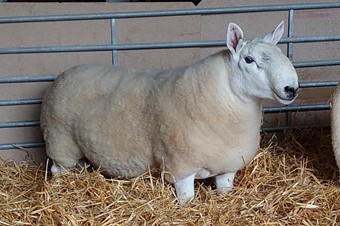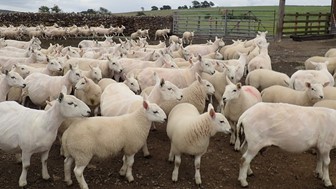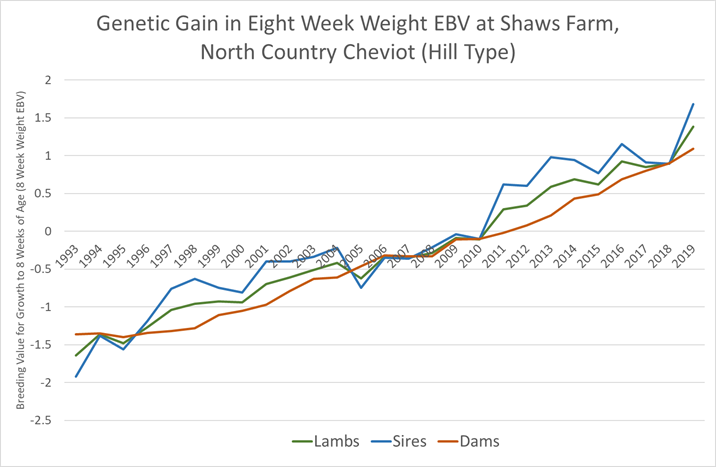Cheviot Recording Case Studies
Genetic Evaluations for Cheviot Sheep Enhanced
Signet has provided sheep recording services to the industry for 50 years. While the recording of terminal sire breeds is easy, our ability to enhance hill breeds is more challenging as data collection is more difficult and breeding objectives are far more complex. However with the genetics staying and performing on the hill generation after generation the prize for getting it right is far greater.
In 2020, Signet relaunched the services that we provide to hill sheep producers.
Enhancements include:-
- Monthly evaluations so that data is available more quickly
- A mixed breed model, so those breeders bringing different breeding lines together – like Park and Hill type Cheviots - can assess any crosses more accurately
- A move to assess carcase traits on a weight adjusted basis, so we can improve the carcase attributes of hill lambs without increasing ewe mature size
- The on-going development of breeding values to assess lamb survival and ewe longevity
- A new hill index to enhance overall flock profitability
Plenty of information about the new services is available on the Signet website, where data can now be analysed more cheaply through online data entry or by using the outputs of farm software.
Here are three short case studies from Cheviot breeders using the service. They highlight that in an era where flocks are tending to get bigger and data collection through the use of EID and farm software is getting easier, this is a good time to think about the attributes of the breed that can be enhanced through genetic improvement and how it can be done.
Case Study 1: Using Ultrasound Scanning to Enhance Carcase Attributes
Thinking about new ways to enhance carcase attributes in the Leam Flock of Park Type Cheviots, County Fermanagh
Sinclair Armstrong’s, Leam flock of Park Type North Country Cheviots based in County Fermanagh have a history of weight recording that dates back to the 1990’s, but with Alastair’s closer involvement in recent years the flock now regularly assesses over 150 lambs per annum – with notable gains in recent years.
By weight recording lambs at around 8 and 21 weeks of age, Alastair is able to find those animals with superior breeding potential for growth rate – as well as maternal lines with superior genetics for maternal care and milk production on the hill. However it is the use of ultrasound to assess carcase attributes that is of particular interest.
Hearing that Signet had re-launched their hill sheep evaluations in 2020, Alastair was interested to learn more about the new approaches being taken to assess muscling and fat characteristics in his lambs.
 “The new approach is good news for hill sheep breeders, as it enables us to enhance the yield of muscle within the carcases of hill lambs without increasing mature size. It also provides a better way to assess and optimise levels of finish, with a small positive weighting on fat to avoid the selection of overly lean breeding lines.”
“The new approach is good news for hill sheep breeders, as it enables us to enhance the yield of muscle within the carcases of hill lambs without increasing mature size. It also provides a better way to assess and optimise levels of finish, with a small positive weighting on fat to avoid the selection of overly lean breeding lines.”
Alastair continued “Breeding hill sheep is always a balance, to retain high levels of maternal performance alongside growth and carcase attributes – but it is really good to see the ultrasound scanning data that we value, being put to even better use in the new analysis.”
To keep up to speed on developments within the Leam flock, as well as their pedigree Charolais and Limousin herds, head to the family Facebook site @LeamLivestock or contact Alastair directly at [email protected].
Pictured: Alfredo 504:RA010, Sire – Humbleheugh Vogue
Case Study 2: Making Your Farm Data Work Harder
Using EID to make better breeding decisions
Kit Acton is no stranger to data collection. The Housesteads flock based up on Hadrians Wall, near Hexham has recorded the performance of over 7,000 Hill type Cheviots over the last 6 lambing seasons, with most of the ewes single sire mated and lambs weighed throughout the year. The data is captured using software provided by Martin Tomkins of Border Software, enabling Kit to make the most of EID to monitor animal and flock performance.
The data provides an important flock management tool and it has quickly enabled him to assess differences between sires, however the assessment of genetic differences in maternal attributes is more challenging – as Kit would acknowledge. Many of the traits of interest that create the ideal breeding ewe - her milk production, maternal care, prolificacy and longevity – are impossible to assess visually when selecting rams and are hard to tease out without some form of data analysis.
 Signet’s evaluations assist in this respect, taking into account the heritability of each trait and pulling forward information on all of an animal’s known relatives - which in a large flock can be hundreds or even thousands of records.
Signet’s evaluations assist in this respect, taking into account the heritability of each trait and pulling forward information on all of an animal’s known relatives - which in a large flock can be hundreds or even thousands of records.
Looking to the future, Kit is interested in some of the planned developments to Signet’s new analysis.
Kit says “The profitability of our flock is strongly influenced by the number of lambs that we rear. We already know there are big differences in lamb survival between different breeding lines – and the ability to assess ease of lambing, numbers of lambs reared and in the near future, lamb survival will make a big difference to our flock.”
He continues “Even with good records this type of assessment is hard to do without access to a genetic analysis – as the genetic influences on each trait tend to be small. However these attributes do have a high economic value and if we can use this to take out low performing breeding lines this will have a big impact on our flock performance in the future. “
For more information contact Kit Acton Email: [email protected]
For information about Border Software, contact Martin at [email protected]
Case Study 3: Breeding Improvement with a Clear Goal in Mind
Celebrating over 25 years of selective breeding with Hill Type Cheviots at Shaws Farm, Scottish Borders
In 1993 the Tennant family performance recorded their first lamb crop at Shaws Farm, Newcastleton. In that year nearly half of the lambs recorded were singles and half were twins. Four years later the number of twins accounted for 60% of the lamb crop; this figure increased and has stabilised over the last two decades at around 66%. Thanks to the foresight of owner, Toby Tennant this lift in the number of lambs produced and reared was just the first wave of improvement that was to arise during more than 25 years of selective breeding within the flock.
Between 2000 to 2003 single lambs on the hill averaged ~15kg at 8 weeks of age. Today they exceed 20kg; with twin born lambs having achieved an even greater lift in performance. These improvements come as part of a two pronged approach, lifting the genetic potential of the lamb to grow – and the genetic potential of its mother to milk and look after the lamb. Genetic trends reflect what is seen on the hill, with high rates of genetic gain achieved over many years, through the careful selection of homebred rams and ewes using the EBVs and Indexes produced by Signet; while at the same time working to minimise inbreeding.
|
|
Average 8 week weight (kg) |
|
|
Singles |
Twins |
|
|
2000 |
13.9 |
11.4 |
|
2001 |
15.3 |
12.7 |
|
2002 |
14.0 |
10.9 |
|
2017 |
20.5 |
17.1 |
|
2018 |
20.1 |
16.7 |
|
2019 |
21.9 |
21.0 |

Ultrasound scanning has been an important feature within the breeding programme, having been used to assess muscling and fatness within the flock. The Shaws lambs scan extremely well for hill lambs – something that is even clearer when the flock is assessed as part of Signet’s new hill analysis.
Looking to the future, Kyle Thomson the Head Shepherd at Shaws says
“I will be continuing to use figures in the Cheviots here so we can continually improve the flock. We have had great success selling fat lambs through the ring and also on a deadweight basis, we attribute the good prices and consistent lamb quality to recording with Signet alongside good stockmanship. As well as looking at the stock, we use figures to decide which stock to sell for breeding and which to keep for breeding. I feel this is key to success in what are looking to be difficult times ahead for the industry."
For more information contact Kyle by emailing [email protected]



